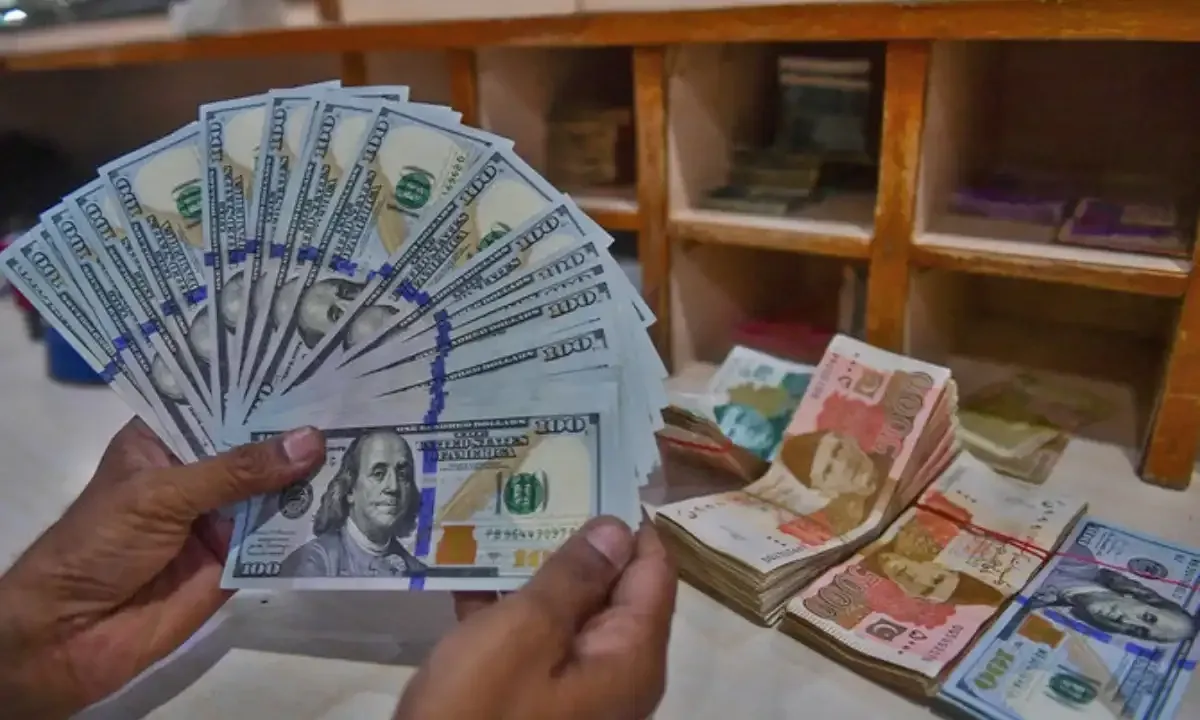Dollar Rate in Pakistan Falls as Rupee Gains Again
Introduction
The dollar rate in Pakistan has once again seen a decline, as the Pakistani Rupee (PKR) continues to show resilience in the interbank market. On Friday, the rupee appreciated by 02 paisa against the US Dollar (USD), closing at Rs. 281.90, compared to the previous day’s closing of Rs. 281.92, according to the State Bank of Pakistan (SBP).
This marks the 11th consecutive trading day of gains for the local currency, sparking cautious optimism about Pakistan’s economic stability and forex market trends.
Dollar Rate in Pakistan: Latest Interbank Performance
The interbank session on Friday reflected a stable performance by the rupee. Although the appreciation against the US Dollar was marginal, the consistency of gains over 11 straight days highlights a significant trend.
- USD to PKR: Rupee appreciated by 02 paisa, closing at Rs. 281.90.
- Euro to PKR: Decreased by Rs. 1.74, settling at Rs. 326.84 from Rs. 328.58.
- GBP to PKR: Fell by Rs. 1.81, closing at Rs. 377.93 from Rs. 379.74.
- Japanese Yen to PKR: Dropped by 02 paisa, closing at Rs. 1.89.
- Emirates Dirham: Remained unchanged at Rs. 76.75.
- Saudi Riyal: Gained by 01 paisa, closing at Rs. 75.13.
This performance shows that the rupee is not only gaining against the US dollar but also strengthening against other major global currencies.
Why Is the Rupee Gaining Strength?
The rupee’s recovery is being attributed to multiple economic and financial factors. Some of the major reasons include:
1. Improved Foreign Exchange Reserves
Pakistan’s foreign exchange reserves, supported by inflows from international partners and remittances, have provided greater stability to the local currency.
2. Strict Monitoring of Currency Markets
The State Bank of Pakistan (SBP) and government regulators have intensified their crackdown on currency speculation and illegal hawala-hundi practices. This has improved transparency and reduced artificial pressure on the rupee.
3. IMF Program and Economic Reforms
The ongoing reforms under the International Monetary Fund (IMF) program have created confidence among investors and markets, ensuring that the rupee remains supported by external financing.
4. Seasonal Remittance Inflows
With overseas Pakistanis sending higher remittances, particularly during key months, the increased dollar inflow has eased pressure on the exchange rate.
Dollar Rate Pakistan: Impact on Businesses and Consumers
The decline in the dollar rate in Pakistan has both short-term and long-term implications for businesses and consumers.
- Imports: Lower dollar rates reduce the cost of imports, especially fuel, machinery, and raw materials.
- Inflation: A stronger rupee can help bring down inflation, as imported goods and petroleum products become cheaper.
- Exports: On the flip side, exporters may face challenges, as a stronger rupee makes Pakistani products relatively more expensive in global markets.
- Public Sentiment: A consistently strengthening rupee improves public confidence in economic stability, which is crucial for market recovery.
Historical Context: The Rupee vs Dollar
Over the last few years, the rupee-dollar exchange rate has been a central topic in Pakistan’s economic discussions. The rupee faced steep depreciation during 2022–2023, crossing Rs. 300 per dollar at its peak.
However, policy measures, IMF support, and tighter regulations have helped the rupee regain lost ground. The current 11-day streak of appreciation is one of the most encouraging signs of currency stability seen in recent months.
Comparison with Other Global Currencies
Pakistan’s rupee is not only stabilizing against the dollar but also showing resilience against other international currencies:
- Euro (EUR): Significant drop by Rs. 1.74 highlights euro’s weakness in the local market.
- Pound Sterling (GBP): A fall of Rs. 1.81 indicates stronger rupee performance.
- Japanese Yen (JPY): Minor decline shows market adjustments.
- Dirham & Riyal: Stable movements reflect regional currency balance.
This broad-based performance strengthens the argument that Pakistan’s currency is experiencing a sustained correction.
What Analysts Are Saying
Currency experts and financial analysts believe the rupee’s recent performance is a positive development, but caution is needed.
“The rupee’s stability is linked to ongoing IMF support, government reforms, and strong remittance inflows. However, external debt repayments and global oil prices remain key risks,” one market analyst noted.
Another expert added:
“If Pakistan continues with fiscal discipline and maintains forex inflows, the rupee could see further stability in the coming months.”
The Role of the State Bank of Pakistan
The SBP’s proactive role in monitoring and regulating the forex market has been instrumental in preventing speculation-driven volatility. The central bank’s policies, combined with strict action against illegal trading channels, have played a key role in stabilizing the dollar rate in Pakistan.
Future Outlook: Will the Rupee Continue to Gain?
While the rupee has gained consistently for 11 sessions, the future trajectory depends on several factors:
- Global oil prices and import bills.
- Timely disbursements from the IMF and friendly nations.
- Stability in political and economic policies.
- Seasonal remittance inflows from overseas Pakistanis.
If these conditions remain favorable, the rupee could continue appreciating, potentially moving closer to the Rs. 280 mark in the near term.
Dollar Rate Pakistan: What It Means for the Economy
A stronger rupee carries both opportunities and challenges:
- Positive Side: Reduced inflation, cheaper imports, improved investor confidence.
- Challenges: Pressure on exporters, slower foreign investment if currency becomes overvalued.
For policymakers, the key will be balancing currency strength with economic growth objectives.
Conclusion
The dollar rate in Pakistan continues to fall as the rupee posts gains for the 11th consecutive day, closing at Rs. 281.90 in interbank trading. With steady improvements against major global currencies, this upward trend reflects a combination of government reforms, IMF support, and stronger forex inflows.
While challenges remain, particularly with external debt and global commodity prices, the rupee’s consistent appreciation offers a glimmer of hope for Pakistan’s economy.
If sustained, this trend could help stabilize inflation, reduce import costs, and restore public confidence in the country’s financial stability. The next few weeks will be crucial in determining whether this momentum continues.
Read More Here:















